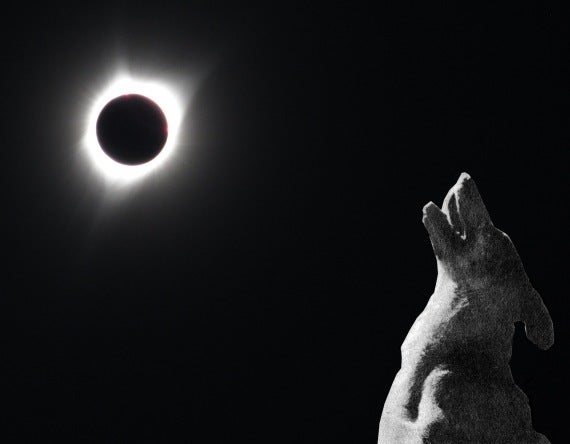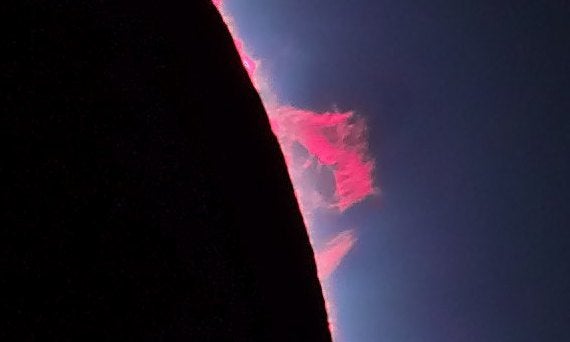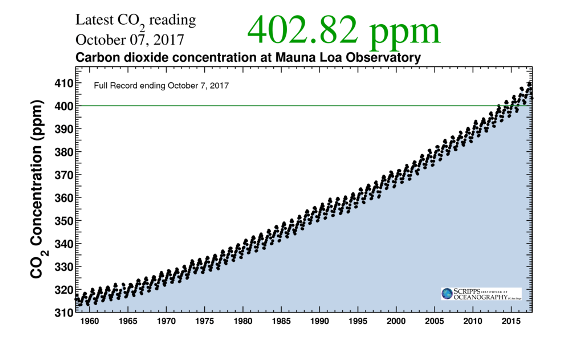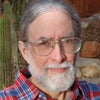
The howl of innate dread.
Dogs don't understand eclipses, but they certainly notice them. I learned this last August as the Great American Eclipse of 2017 approached totality in Smith’s Ferry, Idaho: all the dogs in the area started barking and howling at the strange and seemingly threatening event. They routinely experience the cold and darkness of nightfall, yet somehow they knew it shouldn’t be happening on a perfectly cloudless summer morning. Something had to be wrong.
When the moon’s shadow fell over our distant hominin forebears, their reaction was likely much the same. When did our ancestors begin to see eclipses less in the way of dogs and more in the way we see them now? For millennia humans could predict eclipses in a crude way and understood that the moon was covering the sun, but they still saw them as magical omens. It is only through modern science that we can predict their location and timing with precision. Only science has shown us what the sun really is and how it shines. Only through science have we walked on the moon, and only science can widen our eyes in the way a telescope does. Science magnifies the wonder and banishes the dread of an eclipse.

A wondrous solar prominence captured by Tom Bartol during the eclipse of August 21, 2017.
The dread comes mainly from intuitions: innately programmed responses to situations for which a rapid, stereotyped response improves reproductive success. Fear of snakes and looming shadows are good examples, and the latter may partly explain a dog’s reaction to an eclipse. The intuitions of humans, however, are deep, numerous, and complex, and science has only begun to explore them. They operate mainly beneath our conscious awareness, where they shape our perception, feelings, and behavior. What do I want for lunch? Should I hire this job applicant? Should I marry my girlfriend? We think we are consciously making such decisions, yet most of the process is intuitive, with consciousness doing little more than rationalizing after the fact. This is not to suggest that intuition is always mistaken or bad. To the contrary, it is essential for making complex decisions in the face of overwhelming and conflicting information. My point is that innate intuition can lead us astray because it is primarily a mechanism for enhancing reproductive success, not truth-finding.
For me the eclipse was the grand finale to a glorious month away from civilization that had begun with a long hike in the Sierras. My ruminations on canine and human intuitions were inspired not only by the spectacle in Idaho, but also by the depressing news to which I returned: the white supremacist rally and murder in Charlottesville; the war of childish insults and threats between a North Korean dictator and an American president; and the tiresome barrage of politically themed memes on social media that push us into increasingly extreme factions.

Two of the tamer tribalistic memes on Facebook.
The great division in America is fueled largely by our innate social intuitions. We tend to align ourselves with a tribe, trusting and cooperating with fellow members and feeling suspicion and hostility toward competing tribes. Tribalism served our ancestors well in the Pleistocene, and it is burned so deeply into our brains that we will probably never shake it off, despite the danger it poses in an age of global warming and nuclear weapons.
Like moths to a flame, we are drawn not only to tribes, but especially to narcissistic tribal leaders, and this intuitive quirk explains several vexing religious and political puzzles. Yahweh is jealous, vindictive, self-centered, and surprisingly insecure (Thou shalt have no other gods before me!) — the same traits that, in our less-than-holy president, seduce conservative Christians.
Scientists, of course, also have innate intuitions, and it is only through replication of experiments and the collective insights of a scientific community that they can see around the intuitive blinders of their individual colleagues. But what about the rest of us? Most voters aren’t scientists. How are we to choose among competing healthcare proposals or tax reform plans? Is global warming real or a hoax? How do we find truth in a presidential campaign? How do we find it anywhere?
Science finds truth only approximately, gradually, and with humility. It does so by ruthlessly discarding ideas that cannot be true, because they conflict with empirical evidence from nature. Ideas that survive this winnowing are accepted only as tentative truths to be revised or rejected as new evidence demands. The efficacy of this approach is evident in all that science has wrought, from doubled life spans to footprints on the moon.

One small step closer to truth.
But how can a nonscientist evaluate the Keeling curve or the absorption spectrum of carbon dioxide? Wikipedia helps, but this simple rule of thumb is even better: follow the scientific consensus. Granted, you can’t always use it. There’s no consensus when there’s not enough evidence to decide among competing hypotheses. In that case scientists disagree, and each struggles to find the definitive experiment that will persuade the others. So it is now with the question of how life originated on earth, and so it was with human-caused global warming prior to the 1980s. But when there is a broad consensus among scientific experts, it is only because the evidence is overwhelming, and competing ideas have failed. By this standard you can be fairly confident that the universe is about 13.8 billion years old, that HIV causes AIDS, that evolution is true, and that the problem of climate change is both real and urgent. If you have the time and training to evaluate the evidence for yourself, so much the better.

The Keeling curve — part of why scientists agree on human-caused global warming.
Of course there’s more to truth-seeking than looking for scientific consensus. It begins with adopting a new mindset, an empirical worldview that doesn’t easily fit the human mind. This entails healthy skepticism, some familiarity with logic, and a desire for truth above comfort, certainty, or convenience. Above all it requires a willingness to admit error and discard cherished beliefs when evidence demands it. That kind of humility is surprisingly difficult for most people. How much easier it is to believe what my circle of friends believe; how comforting to accept as inerrant truth the ancient holy book of my childhood training; how calming to be certain of life after death; how good it feels that my tribe is right and theirs wrong.
It need not be this way. We could do better at teaching skepticism and empiricism in our public schools. We could elect grown-ups to public office. We could practice civility and good manners when talking with people of differing views. We could try to solve problems rather than fight over them. For now, however, the sad drivel on social media persists, and we denounce the opposing tribe like dogs barking at an eclipse.
John C. Wathey is an author and computational biologist whose research interests include protein folding, evolutionary algorithms, and the biological forces behind religion. Learn more at www.watheyresearch.com.
For more on the scientific perspective on eclipses, watch the Nova documentary on PBS. And for a six-minute glimpse of the eclipse experience at Smith’s Ferry, Idaho, try this:
